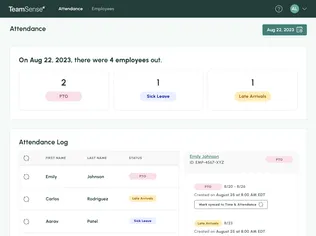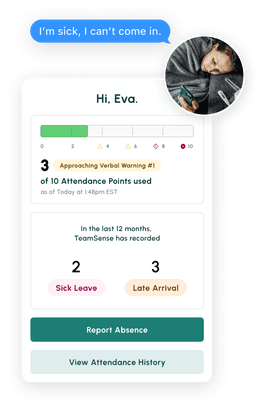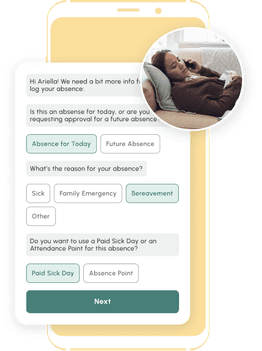When to HR with AI (and When Not To)!
Table of Contents
- What is Workplace Absenteeism?
- What’s the Difference Between a Planned Absence and Unplanned Absence?
- What Causes Workplace Absenteeism?
- The Cost of Absenteeism in the Workplace
- Effects of Excessive Absenteeism in the Workplace
- How to Lower Absenteeism Costs
- Text-Based Absence Management: A Solution for Employee Absenteeism
Around here, we believe your hourly workforce is essential to getting the job done well and keeping the company running smoothly. People are the heartbeat of your operation! But here’s the thing about that—in order to keep that heartbeat pumping, you need your workforce to come into work (imagine that).
But it’s not as easy as it might sound—workplace absenteeism is a real problem. And the cost of absenteeism isn’t cheap either. On a given day, almost one in 10 employees are absent on days they are scheduled to come to work.1 And even though planned vacations and sick call-outs should be expected, abusing your attendance policy shouldn’t. Absences in the workplace can add up quickly and eat away at your profits, your team morale, employee satisfaction, and your overall success.
What is Workplace Absenteeism?
Absenteeism in the workplace happens when an employee makes a habit of not showing up for work. These unplanned and excessive absences add up and can cause major problems for the day-to-day operations of your company. Unexpected absences will pop up from time to time, but excessive absenteeism is a repeated pattern that shouldn’t go unnoticed.
When it comes to absenteeism, we’re not talking about a team member taking PTO for a scheduled holiday or suddenly calling out sick. Absenteeism and unplanned absences mean a team member has been absent from work a lot (and they probably didn’t give a reason for it or bother to call in either).
What’s the Difference Between a Planned Absence and Unplanned Absence?
Even though it might sound pretty straightforward, it can be easy to get confused between what is a planned and unplanned absence. Let’s dive in to cover these a bit more.
Planned Absences
Planned absences include things like paid time off (PTO), vacation, or FMLA. With a scheduled employee absence, employees request time off before and notify their managers or HR department. The team member will usually submit a formal request for the time off through a written time off request form, company app, or through a leave management platform.
Unplanned Absences
Unplanned absences are exactly the opposite and can include events like emergencies, illness, injury, mental health, or personal matters. An unexpected absence is just like it sounds—no one saw it coming. This means employees have to call in at the last minute and give very little notice beforehand. And that’s if they do call in. Some employees don’t end up notifying anyone that they will be absent for the day—which makes an already inconvenient situation that much worse.
Even though workplace absenteeism happens (and should be expected), there are still ways to learn how to reduce absences and lower payroll costs and the number of team members who are out. We’ll cover that a little later, but first, let’s talk about what factors might cause workplace absenteeism in the first place.
Save Hundreds of Hours A Year With TeamSense

See how TeamSense saved HelloFresh 3-4 hours per day managing attendance through text. Read the case study and book your demo today!
What Causes Workplace Absenteeism?
Answering what causes absenteeism isn’t as easy as a simple definition. Most of the time, absenteeism is caused by multiple factors that all add up to an employee not showing up for work that day. The truth is that every team member’s situation is different. Remember, some absences can’t be helped and are legitimate (like calling in sick). But other absences are motivated by something else going on beneath the surface.
For some employees, unscheduled absences can be caused by these things:
- Stress
- Burnout
- Boredom
- Low morale
- Fatigue
- Harassment
- Workplace bullying
- Disengagement
- Health issues
- Sickness
- Injury
- Job hunting
- Family-related issues
- Childcare and elder care
- Lack of enjoyment in their job
- Missing a sense of belonging
- Being angry with their boss
And that just scratches the surface when it comes to the reasons a team member might be absent. The good news is that once you know some of the factors contributing to absenteeism, it makes it easier to tackle the issue.
The Cost of Absenteeism in the Workplace
Workplace absenteeism adds up in more ways than one. Not only does absenteeism not scale well for your company’s bottom line, but it also chips away at productivity and team member morale. And even if you don’t see financial impact of those absenteeism costs right away, the effects of managing absenteeism can add up to further costs down the road (like replacing employees).
People Costs
It’s no secret that when team members are out for any extended periods of the day, it costs the company money—but just how many dollar bills might surprise you. Absenteeism costs U.S. employers $3,600 per hourly employee per year.2 Ouch—that’s a pretty penny. While annual costs of regular absences from PTO and sick leave shouldn’t be a surprise, excessive absenteeism can be a problem that can eat away at your profits pretty quickly and hurt your long-term goals.
Lost Productivity Costs
Of course, loss of productivity increases the cost of absenteeism as well. The estimated loss of productivity due to unplanned absence clocks in at nearly 37%.3 Relying on other team members to pick up the slack when someone is out is costly. Co-workers are almost 30% less productive when providing coverage for a “typical absence day,” and supervisors are nearly 16% less productive.4
Effects of Excessive Absenteeism in the Workplace
Everyone knows absenteeism doesn’t do much to improve the work environment—or your profits at the end of the day. But most people don’t know that the effects of absenteeism in the workplace run deeper than what meets the eye. Like the fact that other team members have to pick up the slack when an employee is absent. Because of this, overtime is used to cover 47% of employee absences.5
Here’s how absenteeism in the workplace makes ripples across the company:
- Unexpected shift changes
- Loss of productivity
- Loss of revenue
- Drop in employee morale
- Drop in employee engagement
- Lack of job satisfaction
- Employee turnover
- Hostile work environment
- Increased call outs
- Concern over employee favoritism
- Tension between co-workers
And that’s just to name a few effects of employee attendance issues in the workplace. Of course, you might notice different issues that come up at your company because of workplace absenteeism. Take note of what those issues are so that you can get to the root of the cause and find a solution that is scalable for your company.
How to Lower Absenteeism Costs
Here’s the secret to lowering the cost of absenteeism—getting your employees to come to work and having fewer absences stack up. And even though a lot of that is out of your control (like when a team member goes on vacation or gets sick), there’s still plenty you do control. Providing an encouraging environment where employees want to be at is just one step in that process. Let’s unpack a few more:
1. Engage in Open Communication
One of the simplest solutions to workplace absenteeism is having open dialog between the employee and management. Believe it or not, having a conversation with your team about absenteeism can help a lot. If there’s an issue there, face it head-on. And if workplace absenteeism hasn’t become an issue yet—great! But make sure that the door of communication is open so that the employee feels comfortable reaching out and telling their manager they’re sick.
It’s a given that employees will be absent from work from time to time, but you want to have an open level of communication so that they feel at ease to reach out and notify you ahead of time. This means managers should work toward promoting engagement with their team. Having engaged employees and team members can do a lot to cut back on absenteeism costs at your company. In fact, a high level of employee engagement can reduce absenteeism by as much as 81%.6
2. Make Policies Clear
A clear absence policy will keep everyone on the same page about attendance expectations. Your employees shouldn’t have to wonder what will happen to them if they don’t show up for work that day. They should know exactly what the protocol is if they are absent and late too often without notice. Don’t give your team a chance to test you on it and see if you follow through because, chances are—they will.
3. Follow Through with Action
Whatever your attendance policy is, make sure you follow through with it. Empty threats won’t help cure workplace absenteeism. An employee improvement plan can go a long way to give your team members something to work toward as they change their attendance habits. You can be as detailed as you want with your improvement plan here, be sure it’s measurable and clear for both you and the employee. Set up guardrails so you can judge if the team member has made any growth by a specific date—for example, no unexcused absences for 60 days.
Whatever you do, be sure you apply the action across the board fairly to everybody. This will help to avoid any accusations of favoritism or unjust treatment of employees.

Is your call-in process terrible? Text reduces no-shows and absenteeism by up to 40%.
Don't believe us? Check out this case study to see how this 3PL benefited.
4. Reward Good Attendance
People love being recognized for doing things well. So why not encourage your team to come to work by making it a competition? Incentivizing employees not to miss a day of work helps morale and increases team member satisfaction. You can do this by letting employees accrue extra PTO and get paid sick leave over time, or hold workplace competitions and give a vacation day as a reward. Get creative and have fun with it!
At the end of the day, just remember: You want other employees to see how you reward good attendance for others, so they’ll follow suit too. Make sure your team sees you celebrate good attendance and give everyone something to work toward. Let your team have a healthy competition with one another and workplace morale will naturally get a big boost.
5. Have a Simple Call-Off System
If your team has to fill out 15 forms, call eight different supervisors, and send a group email to the team just to let you know they’re out sick—that’s a bit much. No wonder employees don’t want to let you know they’ll be out for the day. It takes two hours to do it! Don’t make it harder on your people than it needs to be. It’s important to have a clear, simple, and easy-to-follow way to report absences to the right people. And whatever call-off system you put in place, make sure your team knows how to use it.
Text-Based Absence Management: A Solution for Employee Absenteeism
It’s time to chip away at the costs of absenteeism by making lasting change. And that starts with the way your team reports their absences. If you’re trying to track employee attendance by walking around the assembly line and checking off names on a clipboard—it’s time for a change.
Knowing the big picture when it comes to the cost of employee absenteeism and how it directly impacts your company is essential. That’s why it’s so important to have access to attendance insights and trends. Using absence management software to track absences is a simple way to help you get a snapshot of the attendance situation at your company. No more Excel spreadsheets, no more voicemails, and no more tally marks to add up (remember your clipboard?) Get a clear picture of who calls out the most, if they’re following your attendance policy protocol, and catch common themes that pop up.
Choosing the right attendance management tools matters. That’s why TeamSense uses text to let your team communicate their absence to you - see how we stack up against the competition. Relying on text to call-off lets your employees use a technology they’re familiar with—no apps to download, no company login information to remember. Text is a platform that unites almost everyone on your team. From Gen Z to Baby Boomers—text is the lowest common denominator when it comes to communicating with your team. Send yourself a text to see how it works.
When it all boils down to it, the cost of absenteeism is about more than just dollar signs alone. The stress and burnout that workplace absenteeism causes can have far-reaching, lasting effects on employee health that will cost your company even more in the long run. Make absence reporting easier for your team and watch your annual cost of absenteeism start to improve.

No one wants to talk to their boss or a 1-800 stranger to call off. Text changes everything - Reducing No Call No Shows.
About the Author

Sheila Stafford, CEO of TeamSense & AI in HR Innovator
As CEO of TeamSense, Sheila Stafford is at the forefront of transforming HR for frontline teams through AI-driven solutions. With a commitment to enhancing employee relations and simplifying workforce management, Sheila leads TeamSense in pioneering advancements that empower both frontline employees and HR teams. Her visionary approach combines cutting-edge technology with a thoughtful focus on enhancing human connection; Sheila strategically implements AI where it adds the most value while recognizing the critical role of personal interaction and ensuring that human engagement remains central when it matters most. Under her leadership, TeamSense is redefining how companies support and engage their frontline teams for a more connected, efficient workplace.





